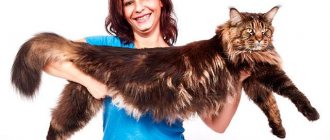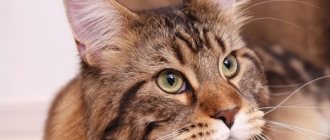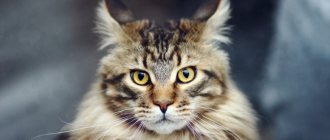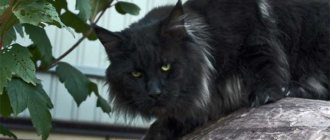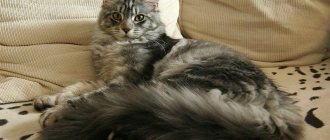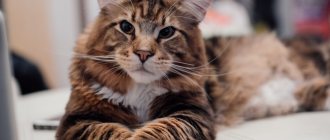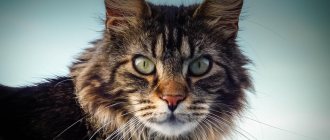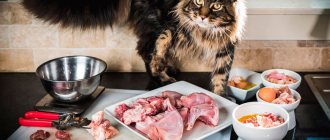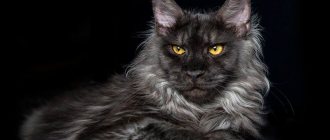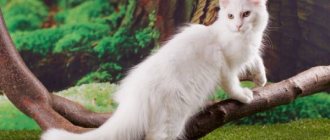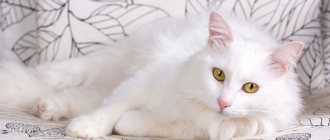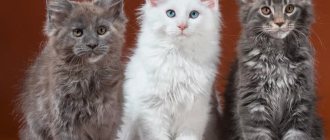To find out for sure whether your kitten is a representative of the Maine Coon breed, to assess its prospects as a sire and to predict the chances of receiving regalia and titles at exhibitions, you need to know the breed standards.
There are different associations of cat lovers and breeders, each of them develops its own judging rules for a particular breed. These standards are basically similar to each other, but still have differences.
For the Maine Coon breed, the most current standards at the moment were created by the WCF (World Cats Federation), FIFe (Federation International) and TICA (The International Cat Association) systems. Despite a lot of nuances, they all paint the same image of a “correct” Maine Coon cat. A detailed study of the standards helps to clearly imagine the appearance of a thoroughbred “coon”.
Body
The Maine Coon is the largest of the domestic cats. The average weight of an adult Maine Coon is 6-8 kg. Cats reach 9-10 kg; exceeding this parameter, as a rule, indicates that the handsome furry cat is obese. The body length of an adult is up to 135 cm, the height at the withers is from 25 to 45 cm, which is comparable to a fairly large dog. Cats are smaller than cats and more gracefully built. See also photos of an adult Maine Coon.
The build is dense, moderately stocky. The body is elongated horizontally, the silhouette has a rectangular outline. This breed has heavy bones and well-developed, trained muscles. Thanks to excellent muscle tone, the body radiates a feeling of strength and power.
The neck is solid, of medium length, looking like a strong pillar. As a rule, the neck is framed by a magnificent thick collar. The sternum is wide and powerful. The paws are strong, strong, proportional to the body. The feet are large, rounded, and bushy hair grows between the toes.
The tail is longer than average, normally reaching to the animal's shoulder or more. Covered with silky flowing strands. The root of the tail is thickened, closer to its end the tail becomes thinner. The outline of the tail resembles a fan.
Subtle physique, fragile bones, long legs, bob tail, as well as excessive stockiness and “squareness” of the body do not meet the standard, which means they are fined during the evaluation of the animal.
Nutrition
When purchasing a small Maine Coon, it is better to feed him his usual food for a while. Then you can introduce the kitten to other foods.
A complete diet for a small Maine Coon should contain up to 40% protein, 15-30% fat, 2.5% fiber, and the rest should be carbohydrates.
When feeding kittens, it is important to follow a diet. The main diet is raw lean meat. These are beef, chicken, rabbit, and offal. To strengthen joints, you need chicken scallops, beef tendons, and pig ears. Meat should be frozen for at least three days.
The source of minerals will be raw chicken necks, heads, backs, paws, and tails. They must be ground or given whole. Raw yolk is very useful for kittens.
When purchasing a small Maine Coon, it is better to feed him his usual food for a while
Fish should be given with caution and infrequently. Kittens drink milk for up to two months, and then their body loses the ability to digest lactose. It is replaced with fermented milk products, cottage cheese, and hard cheese.
Sometimes kittens happily eat raw grated vegetables and fruits and herbs. Adding a small amount of olive oil will help. There must be clean water available at all times.
It is not recommended to feed kittens food from the human table: it contains too many different additives that are harmful to the animal’s digestion.
Natural nutrition table for Maine Coon kittens by month
The nutritional norms and diet for Maine Coon kittens are presented in the table:
| Age in months | Daily value in grams | Number of feedings per day | Diet |
| Up to a month | Around the clock | Mother cat's milk | |
| 1,5-2 | 150-190 | 6 | Milk, liquid porridge, pureed meat |
| 2-3 | 180-240 | 4 | Raw lean meat, liver, some sea fish, vegetables, fruits, egg yolk, kefir, yogurt, a little olive oil. |
| 3-6 | 180-220 | 4 | Offal, chicken feet, heads, backs are added |
| 6-9 | 200-250 | 3 | Same diet |
| 10-12 | 180-220 | 2 | Same diet |
Feeding kittens with prepared food
High-quality industrial cat food contains all the necessary nutrients. Some manufacturers produce special food for Maine Coons: Bosch Sanabel Kitten, Royal Canin, Hills.
Be sure to read:
What to feed a Maine Coon kitten: recommendations, diet from a month to a year, what not to give
The amount of dry food is calculated individually and depends on the size of the kitten. First, the granules should be diluted with store-bought milk. Adults can be given canned food.
Industrial feeds are stored for a long time and are convenient to use. The packages usually indicate the serving size and other recommendations.
Head
Maine Coons have a medium sized head or slightly larger. The shape is wedge-shaped. A round or small head is a fault and will be penalized when judging.
At the same time, you need to understand that a cat has a larger head than a cat, and its size must be determined in relation to the proportions of the body, and not by comparing it with other representatives of the breed.
The outline of the skull is close to square. The forehead is thoroughly rounded. Noble sculpted cheekbones, clearly defined. The boundaries of the cheekbones should be clearly palpable. Whiskers (pads under the vibrissae) smoothed.
The nose is ordinary, medium in size. The square chin is in the same vertical plane with the nose and upper jaw of the animal. If the chin protrudes forward, this is a gross violation of the standard.
The profile is elegantly curved and has a slight gentle slope. A slight convexity is acceptable at the bottom of the bend. A straight profile, the presence of a dip or a very noticeable convexity at the end of the nose are significant exterior flaws. The structure of the muzzle is proportional, with good relief.
Cat's character, interaction with other animals, owners and children
The Maine Coon is an active and quite energetic animal. Such a cat needs constant attention - you need to play with it and let it run around the apartment. The animal has the habits of a born hunter, and it will happily play with a mechanical mouse, catch soap bubbles or a ball.
You don't have to be afraid to get this cat if you have children in the house. Maine Coons live in peace with children and never offend their little owners. However, these cats do not always get along easily with other pets. You should not get such a pet if there is a rodent living in the apartment - a chinchilla, guinea pig, hamster. A Maine Coon may attack an animal, considering it potential prey.
Otherwise, these animals are not aggressive, have a friendly character, and adapt well to any conditions. Cats have developed intelligence, which allows them to understand their owner literally at a glance. The Maine Coon can be taught some tricks if the lesson is done in a playful way.
Maine Coons have a gentle voice that many owners describe as a "musical purr." It is believed that it is impossible to find two kittens with the same timbre - the voice of each has individual characteristics.
Eyes
Maine Coons have expressive oval eyes. When a cat opens its eyes in surprise, their shape becomes almost round. The location relative to the outer edge of the ear is slightly oblique.
The defects are an almond-shaped eye shape, a frank slant of the fit, a flat edge of the upper eyelid with wide open eyes. All three standards under consideration have different requirements for eye shade.
WCF insists on monochrome eye color, and this standard also requires harmony between eye color and fur color. The FIFe standard has no requirements for eye color; the only preference is purity of color.
The color scheme of a cat's skin and the color of the iris do not depend on each other. Any combinations are acceptable. TICA allows green and gold color palettes. Animals with white fur may have blue or multi-colored eyes. The correlation between skin color and eye color is not considered.
What influences development
The development of a purebred pet is influenced by the following factors:
- Floor; girls are usually born smaller in size than male maikunas; Adult cats are also different; they weigh less.
- Number of babies in the litter; most often 4-5 individuals are born. If a cat has 6-7 kittens, each weighs about 100-120 g;
- Parameters of the mother and her nutrition during pregnancy. Food rich in proteins, fats, vitamins and beneficial microelements will support the cat’s health and provide the baby’s body with the necessary substances;
- Conditions of detention; a clean, healthy, vaccinated and treated animal for ticks, fleas and worms is stronger than its unkempt counterparts;
- Selection work of the breeder; affects the formation of the skeleton and skull of the pet.
- Stressful condition in a cat. The composition of mother's milk in an unfavorable situation deteriorates, this affects the growth of babies.
Ears
Maine Coons have large ears. The auricle is triangle-shaped with a wide base, the tip of the ear is narrow and moderately sharp. The delivery of the lugs is high, directed upward at a slight angle.
The space between the ears is equal to the width of the ear at the base, but may increase slightly with age. If the distance between the ears is too large, this is a flaw in the exterior. “Collapsing” ears are also a defect.
The fur covering the ear is long, with protruding strands extending beyond its contours. It is preferable that the ears are crowned with tassels “a la lynx”, with a vertical extension along the back of the ear. Any size and thickness of brushes is allowed.
Comparative table of the rating scale in points
| Category | CFA | TICA | FIFe | WCF |
| Head | 30 | 40 | 40 | 30 |
| Head shape | 15 | 8 | ||
| Eyes | 5 | 5 | ||
| Ears | 10 | 10 | ||
| Eye shape and fit | 5 | |||
| Ear shape and placement | 10 | |||
| Body | 30 | 35 | 35 | 35 |
| Frame | 15 | 10 | ||
| Limbs | 5 | 3 | ||
| Neck | 5 | |||
| Tail | 5 | 5 | ||
| Backbone | 7 | |||
| Musculature | 10 | |||
| Coat, color, pattern, eye color | 35 | 25 | 20 | 30 |
| Wool | 20 | 25 | 20 | |
| Balance | 5 | |||
| Condition | 5 | 5 |
Historical reference
For the first time they started talking loudly about representatives of the Maine Coon breed after the international exhibition of 1861 . When everyone was fascinated by the beautiful, phlegmatic giant from North America. It is the state of Maine in the northeastern United States that is considered the birthplace of these fluffy beauties, also called “coon cat” and also having tufts on the tips of their ears, similar to lynx cats.
Hence the origin of some legends telling about the appearance of these cats as a result of crossing, in one case - between cats and raccoons, in another - between cats and lynx.
This is interesting! There are also more realistic assumptions that speak in favor of the appearance of these animals in North America as a result of travel on ships from Europe: with the Vikings, with the property of the Queen of France, or with a certain Captain Kuhn.
The most plausible explanation seems to be the origin of this breed as indigenous to the specified territory as a result of many years of work by nature itself, endowing the feline representatives with certain features that allow them to better withstand difficult weather conditions.
And the climate of this state is not particularly mild: humid summers and snowy, frosty winters - these factors influenced the transformation of Maine Coons and gave them such properties as thick long hair, a powerful body, high paws, and long mustaches. By the nature of the Maine Coon - calm, concentrated, even phlegmatic - one can judge his self-confidence.
The history of human friendship with this breed goes back more than 150 years: at first, Maine Coons were indispensable assistants to farmers in the fight against rodents - their textured beauty remained unnoticed by their owners and was underestimated, until the already mentioned 1861.
In the middle of the last century, Maine Coons were also appreciated by residents of Europe, and since then this breed has confidently been among the top ten in popularity in the world, and in some countries of the world - in the top five and even in the top three. Exhibitions of this breed are held by many felinological organizations; best known for their activities:
- WCF (Word Cat Federation);
- TICA (The International Cat Association inc.);
- FIFE;
- CFA et al.
Return to content
What diseases are representatives of this breed prone to, and what is their life expectancy?
Maine Coons usually have not only large dimensions, but also good health. Some pathologies still occur. The most common Maine Coon diseases are:
- Cardiomyopathy. This disease can cause heart attacks and paralysis of the hind limbs, leading to death.
- Kidney cyst. It occurs most often in these animals due to improper feeding.
- Spinal muscular atrophy. The disease significantly reduces the Maine Coon's quality of life.
Where to buy a Maine Coon kitten
You should not buy kittens of this breed based on advertisements on unverified sites. There is a risk of purchasing an animal that is sick from birth or a mixed breed rather than a purebred one. It is very difficult or almost impossible to find coons at bird markets. It is recommended to purchase a kitten from specialized breeders. When purchasing, you must receive all the documents for the kitten - its pedigree, which will indicate:
- parents;
- all his ancestors;
- information about them.
The price of a kitten depends on the nursery, the pedigree of the animal, its color and other factors.
Choice of kittens.
